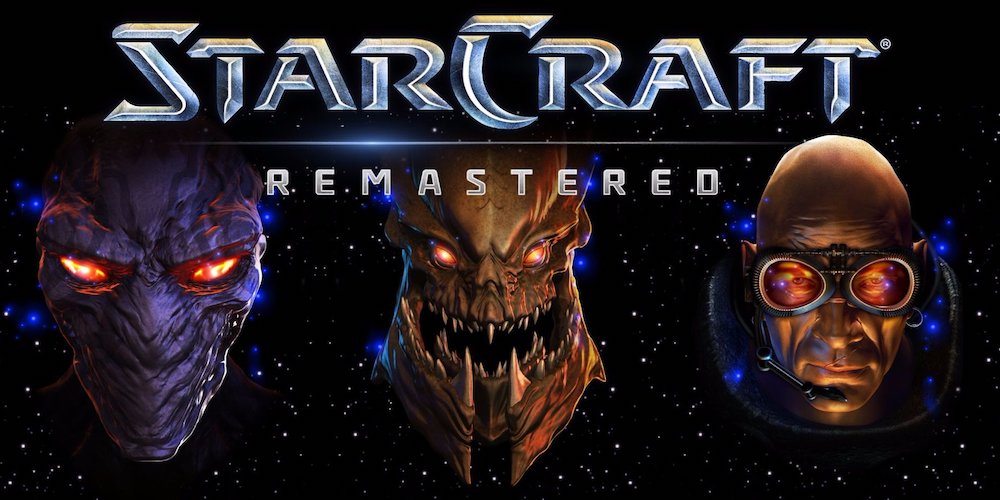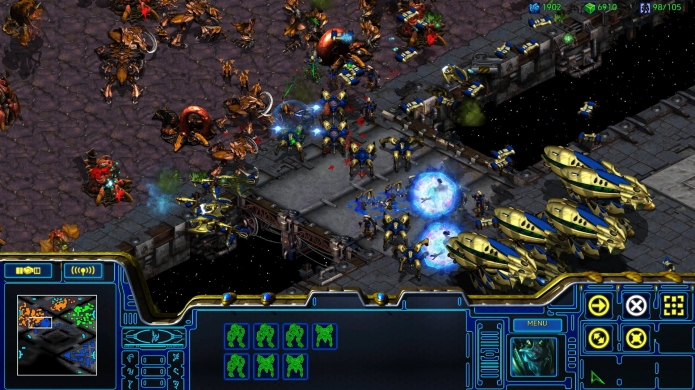
Ah, StarCraft. Perhaps the original eSports phenomenon. Twenty years on, it’s a whole thing unto itself that its creators at Blizzard could hardly have foreseen: a competitive RTS defined as much by its flaws as its innovative asymmetrical design. The fact that it has retained a following through the waxing and waning of many other RTS series, including its modern sequel, speaks to these specific qualities. And now Blizzard has decided to give it the makeover it has long deserved.
For the uninitiated (I doubt there’d be many of you, but I should cover my bases), StarCraft is a real-time strategy game. This means the player collects resources, constructs buildings, trains an army, and controls that army to try and defeat their opponent by destroying all their stuff, all while their opponent is trying to do the same to them. In StarCraft, the player takes one of three races: the human Terran, the bug-like Zerg, or the ethereal-robotic Protoss. They’re quite different from each other, but here’s the catch (with twenty years of research behind it): they’re all good. The game caught on as a competitive sport, particularly in South Korea, after its expansion Brood War was launched in 1998. (Note: The Brood War expansion is included in StarCraft: Remastered, so I’m going to continue referring to both the original game and its expansion collectively here as “StarCraft”).

But of course, twenty years is old for a game, and the original StarCraft looks its age. Not only that, but as with many games from its era, it had been a struggle to get StarCraft working on new PCs, with their new fangled operating systems and ridonculous widescreen 4k resolutions. To that end, it was pretty exciting to hear that Blizzard was working on a reissue of their original breadwinner, tempered by mild concerns that they would go and royally mess with the things that made StarCraft what it was. All StarCraft: Remastered arguably had to do to be a “success” was make the game easily playable again. And this was achieved – before it even launched – when Blizzard patched the original game for the first time in yonks to put it in working order for modern operating systems, before making it completely free to play. These updates to the original game are tangentially the best part of the whole project, and it’s arguably not even part of the game I’m meant to be reviewing.
The HD “Remastered” upgrade itself is $20, and it’s basically a shiny skin. You just click a button and ta-da, the game looks nicer and fits to your 16:9 monitor better. The HD graphics are pretty tasteful – it’s a cleaner and crisper look without being at all over the top. It’s like playing the version of the game you’d misremembered because you’d forgotten how old it really is. I think they’ve done a great job here, honestly, and I’m pretty impressed by whatever witchcraft allowed them to integrate shiny graphics and widescreen without also reworking the twenty-year-old game underneath it. What a marvel of restoration. They’ve also apparently re-recorded all the game’s audio, which I wouldn’t have even realised had I not read it on Wikipedia – it seems basically identical to how I remember and thus wildly nostalgia-inducing.

The other major contemporary roadblock for StarCraft was that, while it had long been a beacon of competitive gaming, the inbuilt competitive ladder had long been discarded by players in favour of third-party systems. Above all, this was another barrier to entry for new players and meant that setting up 1v1 games inevitably involved way more time and effort. So it’s great that Blizzard has addressed this as well, by re-instating their own ladder and matchmaking systems on Battle.net.
In any case, I’ve now had my ass handed to me enough times to confirm that, yes, the matchmaking system usually works (occasionally it didn’t, but hopefully its consistency will only improve with further tweaks). Wait times for games ranged from thirty seconds to two minutes. Refreshingly, the map pool is drawn from tried and tested maps from the existing competitive scene rather than speculative in-house offerings. The classic StarCraft Battle.net mechanical aesthetic is there alongside the chat rooms and custom game lists that I remembered so fondly. When I got tired of having my ego dismantled in 1v1, I played some vaguely quaint PvE custom games, where I was able to lose my team the game and subsequently be accused of being a “noob,” which was a fair and true thing for that person to say. It felt just like being thirteen again.
Even with refurbishings, StarCraft is still a game out of time. It has flaws, glitches, and the clunky UI limitations that it came boxed with twenty years ago. A lot of the units in the game still have laughably bad pathfinding. The player can only select a maximum of twelve units at once, and only give construction orders to one building at a time. This may sound weird, but the fact that the game remains like this is very deliberate, as it’s an essential part of its success as a competitive entity. These control limitations raise the skill-ceiling to near infinite heights, which is part of what makes StarCraft so compelling as an eSport. It is great in a way that is of its time, and it couldn’t possibly be made new this way today. Full credit to Blizzard for coming to terms with this and keeping their hands off the core gameplay as much as possible. It must have been tempting to do otherwise.

So far as the single-player campaign goes, it’s been left more or less as I remember it, just with some aesthetic augmentations thrown in. Between the missions, they’ve added some noir comic-style illustrations for narrative screens that used to be just text. These are fine. You can turn them off, which I did for testing, and then I couldn’t work out how to turn them on again. The story itself is pretty much what I remember it being, although the dialogue that fills it seems somewhat cheesier – I suspect this might be the result of me getting older rather than actual changes. Some of its storytelling qualities do hold up, though. Particularly, it has much less of a hero complex than the big-budget sequel disappointingly slouched into. The missions are constructed, so the player often finds themselves on the edge of a galactic conflict rather than necessarily always at the center of it. It’s a design choice that shows remarkable restraint, and the narrative remains much more interesting for this.
It’s almost perfect so far as do-over’s go, but I can think of a couple of other things I would like to see. The game still only has the one AI difficulty, which is a shame, as Brood War itself has been a hotbed for AI system testing over the years. There’s surely a lot of good bots out there that could have been integrated into the base game. The bots that come with the game are not particularly useful, 1v1, and there aren’t other inbuilt avenues to practice before heading online. In a game with such a high barrier to entry, this is a slight problem. It also seems that the ladder maps aren’t readily available to be tested out in single-player so anyone interested in getting some good practice in before stepping into the arena will have to go downloading the maps for themselves first.

In the end, I think it’s fair to say that there are two main things StarCraft: Remastered has going for it. One is nostalgia, which it feeds off simply by tastefully re-packaging StarCraft, a game which so many of us played growing up. If you’re looking to re-experience the campaign pretty much as it was, or if you’re looking to have a good ol’ time playing archaic tower defense custom games with randoms on the internet like it’s still 2001, you can do these things – they’re all there waiting for you. The other is that StarCraft is still, probably, the quintessential competitive RTS, and if someone is willing to put their time and ego aside to learn what has to be one of the hardest PvP games going around, Remastered has opened the doors and invited them in. As to whether anyone actually has that kind of time in the face of other modern distractions, well, that’s outside the scope of this review.











